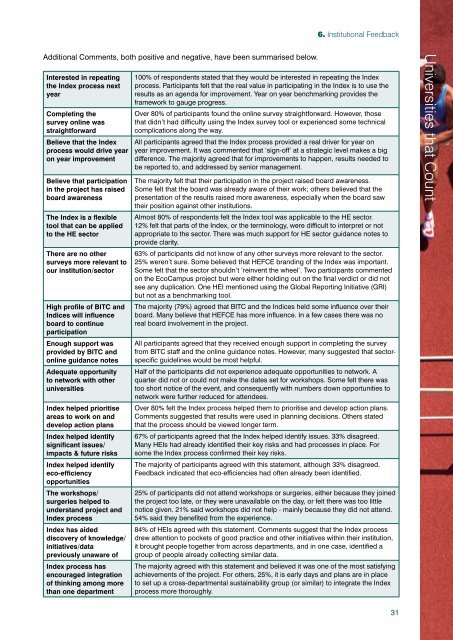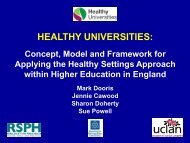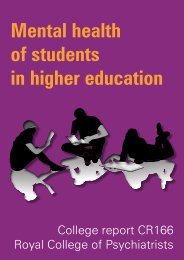Universities
Universities that Count - EAUC
Universities that Count - EAUC
- No tags were found...
Create successful ePaper yourself
Turn your PDF publications into a flip-book with our unique Google optimized e-Paper software.
6. Institutional FeedbackAdditional Comments, both positive and negative, have been summarised below.Interested in repeatingthe Index process nextyearCompleting thesurvey online wasstraightforwardBelieve that the Indexprocess would drive yearon year improvementBelieve that participationin the project has raisedboard awarenessThe Index is a flexibletool that can be appliedto the HE sectorThere are no othersurveys more relevant toour institution/sectorHigh profile of BITC andIndices will influenceboard to continueparticipationEnough support wasprovided by BITC andonline guidance notesAdequate opportunityto network with otheruniversitiesIndex helped prioritiseareas to work on anddevelop action plansIndex helped identifysignificant issues/impacts & future risksIndex helped identifyeco-efficiencyopportunitiesThe workshops/surgeries helped tounderstand project andIndex processIndex has aideddiscovery of knowledge/initiatives/datapreviously unaware ofIndex process hasencouraged integrationof thinking among morethan one department100% of respondents stated that they would be interested in repeating the Indexprocess. Participants felt that the real value in participating in the Index is to use theresults as an agenda for improvement. Year on year benchmarking provides theframework to gauge progress.Over 80% of participants found the online survey straightforward. However, thosethat didn’t had difficulty using the Index survey tool or experienced some technicalcomplications along the way.All participants agreed that the Index process provided a real driver for year onyear improvement. It was commented that ‘sign-off’ at a strategic level makes a bigdifference. The majority agreed that for improvements to happen, results needed tobe reported to, and addressed by senior management.The majority felt that their participation in the project raised board awareness.Some felt that the board was already aware of their work; others believed that thepresentation of the results raised more awareness, especially when the board sawtheir position against other institutions.Almost 80% of respondents felt the Index tool was applicable to the HE sector.12% felt that parts of the Index, or the terminology, were difficult to interpret or notappropriate to the sector. There was much support for HE sector guidance notes toprovide clarity.63% of participants did not know of any other surveys more relevant to the sector.25% weren’t sure. Some believed that HEFCE branding of the Index was important.Some felt that the sector shouldn’t ‘reinvent the wheel’. Two participants commentedon the EcoCampus project but were either holding out on the final verdict or did notsee any duplication. One HEI mentioned using the Global Reporting Initiative (GRI)but not as a benchmarking tool.The majority (79%) agreed that BITC and the Indices held some influence over theirboard. Many believe that HEFCE has more influence. In a few cases there was noreal board involvement in the project.All participants agreed that they received enough support in completing the surveyfrom BITC staff and the online guidance notes. However, many suggested that sectorspecificguidelines would be most helpful.Half of the participants did not experience adequate opportunities to network. Aquarter did not or could not make the dates set for workshops. Some felt there wastoo short notice of the event, and consequently with numbers down opportunities tonetwork were further reduced for attendees.Over 80% felt the Index process helped them to prioritise and develop action plans.Comments suggested that results were used in planning decisions. Others statedthat the process should be viewed longer term.67% of participants agreed that the Index helped identify issues. 33% disagreed.Many HEIs had already identified their key risks and had processes in place. Forsome the Index process confirmed their key risks.The majority of participants agreed with this statement, although 33% disagreed.Feedback indicated that eco-efficiencies had often already been identified.25% of participants did not attend workshops or surgeries, either because they joinedthe project too late, or they were unavailable on the day, or felt there was too littlenotice given. 21% said workshops did not help - mainly because they did not attend.54% said they benefited from the experience.84% of HEIs agreed with this statement. Comments suggest that the Index processdrew attention to pockets of good practice and other initiatives within their institution,it brought people together from across departments, and in one case, identified agroup of people already collecting similar data.The majority agreed with this statement and believed it was one of the most satisfyingachievements of the project. For others, 25%, it is early days and plans are in placeto set up a cross-departmental sustainability group (or similar) to integrate the Indexprocess more thoroughly.<strong>Universities</strong> that Count31





